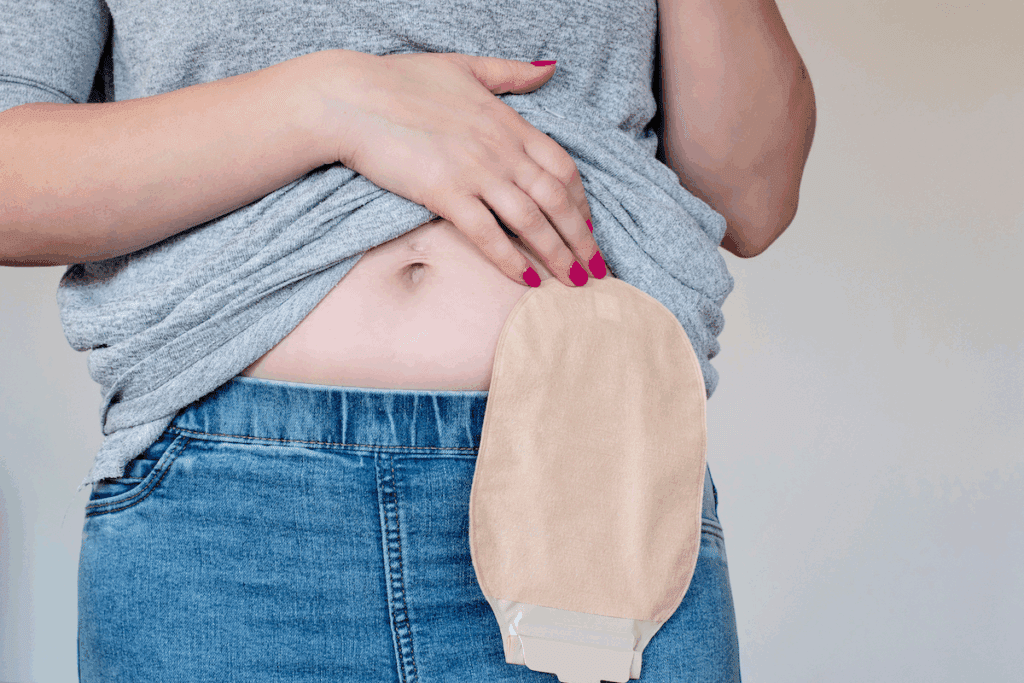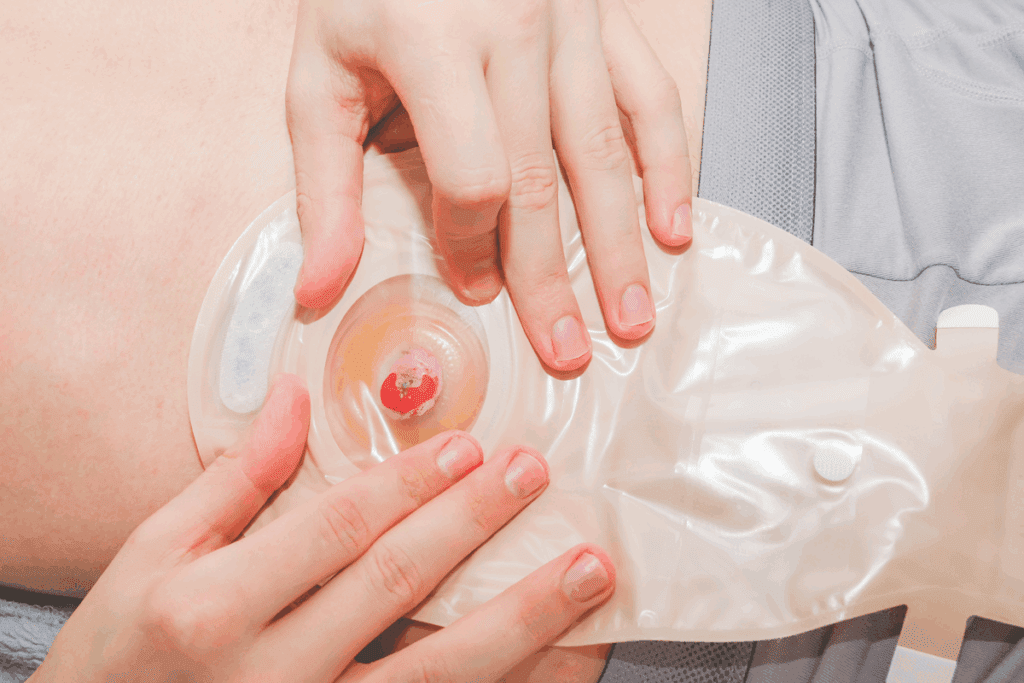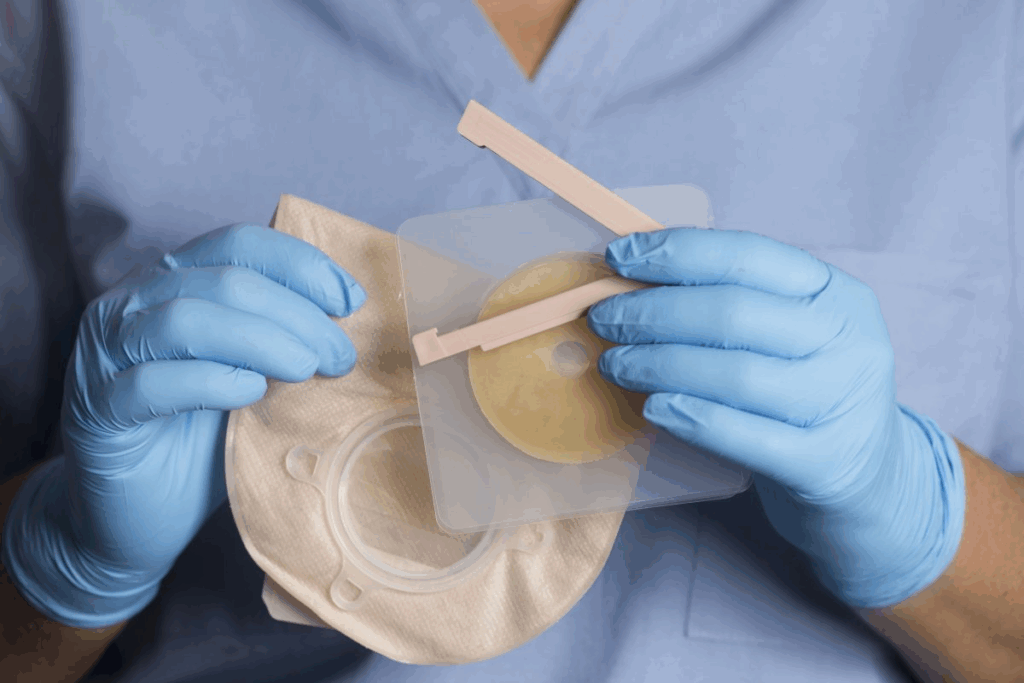Last Updated on November 26, 2025 by Bilal Hasdemir

Managing a colostomy bag is key for those with a stoma. It keeps you comfortable, clean, and confident every day. A colostomy bag collects waste from your body through a stoma.Learn what does a colostomy bag look like, how to empty it safely, and care for your stoma.
The United Ostomy Associations of America suggests emptying the pouch when it’s 1/3 or 1/2 full. It’s vital to empty the colostomy bag right to avoid leaks and keep your skin healthy.
For expert help, turn to Liv Hospital. They offer reliable methods and care insights to guide you through each step.

A colostomy bag is a medical device that collects waste from a stoma. A stoma is a surgically made opening in the abdomen. It’s key for managing waste for those with a colostomy.
A colostomy creates a stoma to bypass the lower colon or rectum. It’s often done for colorectal cancer, diverticulitis, or severe bowel disease. This way, the body can keep eliminating waste even when the usual path is damaged or healing.
Common reasons for a colostomy include:
The stoma is a new way for waste to leave the body. It’s usually on the abdomen and is managed by the person. It’s not natural but is needed for waste elimination after a colostomy.
The stoma’s size and shape can change. It might be temporary or permanent, based on the colostomy’s reason.
Colostomy bags, or ostomy bags, collect waste from the stoma. They’re made to be durable and block odors for comfort and privacy. The bag sticks to the abdomen with an adhesive or coupling system, sealing around the stoma.
The bag holds bodily waste, letting people live their daily lives without worry. It can be drainable or closed-end, depending on the system. It’s important to empty or change the bag regularly for hygiene and to avoid problems.
Knowing how colostomy bags work helps those with a colostomy manage their condition better. It improves their life quality.

Colostomy bags come in many shapes, sizes, and materials. They are made to be discreet and comfy for those with a stoma.
These bags are soft, flexible, and waterproof. They are made to last and can be worn under clothes without anyone noticing. They also keep smells in, so users can feel confident all day.
The look of colostomy bags can change. Some are stiffer, while others are very flexible. People choose based on what they need and like.
There are many sizes of colostomy bags for different body types and stoma sizes. Some bags hold more than others, and some are made for special activities. This means there’s a bag for everyone’s needs.
Colostomy bags are made to be hidden under clothes. They stick to the body with an adhesive or belt. They are flat and don’t show, so people can wear what they like.
Tips for wearing colostomy bags discreetly: Wear loose clothes to hide the bag better. Choose comfy clothes that don’t press on the stoma or bag.
It’s important to know about the different types of colostomy bags and systems. This knowledge helps people with a colostomy find the right fit for their lifestyle and medical needs. There are many types of bags to choose from.
Colostomy bags come in one-piece and two-piece systems. A one-piece system has the pouch and adhesive flange together. This makes it easy to apply and keeps it hidden under clothes. A two-piece system has the pouch and flange separate. This allows for easy removal and reattachment, which some find convenient.
Choosing between one-piece and two-piece systems depends on personal preference and needs. For example, someone with dexterity issues might find a one-piece system easier. Others might like the flexibility of two-piece systems.
Colostomy bags also differ in whether they are drainable or closed-end. Drainable bags have a bottom outlet for emptying. They’re good for people with liquid stool. These bags are often used by those with colostomies or ileostomies.
Closed-end bags are for solid stool and are thrown away when full. They’re preferred by those with solid output. These bags are easy to use and don’t need to be emptied.
There are also specialized colostomy bags for different activities and needs. For example, there are bags for swimming or sports. They offer extra security and discretion.
There are also bags for specific needs, like overnight use or odor reduction. These specialized bags help people with colostomies live active and fulfilling lives. They ensure minimal disruption from the ostomy.
Knowing when to empty your colostomy bag is key to staying comfortable and avoiding leaks. It’s all about timing and listening to your body’s signals.
Experts say to empty your bag when it’s 1/3 to 1/2 full. This keeps the bag from getting too heavy. Heavy bags can cause leaks or fall off.
“Emptying your bag when it’s about one-third full can significantly reduce the risk of accidents,” notes a leading ostomy care specialist. “It’s a simple habit that can make a big difference in a person’s quality of life.”
How often you empty your bag depends on your diet, the type of colostomy, and how much you produce. You might need to empty it after meals or when you’re more active.
Some signs mean you need to empty your bag right away. These include:
If you notice any of these signs, find a private spot to empty your bag quickly.
By following these tips and listening to your body, you can manage your colostomy bag well. This helps you stay comfortable and confident all day.
Getting ready to empty your colostomy bag is important. It’s not just about the act of emptying. It’s about making sure the process is safe and keeps your dignity.
The first thing to do is gather all the supplies you need. You’ll need a toilet or a special container, toilet paper or wipes, a clean cloth or disposable wipes, and a new bag or closure if you need one.
It’s important to have a clean and private place to empty your bag. At home, this means using a clean bathroom. Away from home, find a clean and private spot.
Tips for a Clean Environment:
Keeping your hands clean is key before and after touching your bag. Washing with soap and water is best. If not possible, use hand sanitizer.
Consider wearing gloves for extra protection or if your skin is sensitive. Gloves add an extra layer of hygiene and comfort.
| Preparation Step | Description | Importance Level |
| Gathering Supplies | Having all necessary items within reach | High |
| Clean Environment | Ensuring the area is clean and private | High |
| Hand Hygiene | Washing hands before and after handling the colostomy bag | Critical |
It’s important to learn how to empty a colostomy bag right. This keeps you clean and confident. The steps are simple and ensure a safe experience.
Start by sitting comfortably over the toilet. You can sit on the seat or stand in front, based on what feels right for you. Make sure you can easily reach and hold the bag to avoid spills.
Then, open the drainage closure at the bag’s bottom. Hold the bag over the toilet and slowly open it. Try to keep the bag close to the toilet to avoid spills.
Let the bag’s contents flow into the toilet. You might need to squeeze the bag a bit to get everything out. Make sure it’s empty to avoid smells and leaks.
After emptying, clean the opening with toilet paper or a damp cloth. This keeps things clean and stops bacteria from growing. Once clean, close the opening tightly to stop leaks.
By following these steps, you can empty your colostomy bag safely and hygienically. Doing it regularly will make it easier and boost your confidence in caring for your colostomy.
Knowing how to empty various ostomy systems is key for those with ostomies. Each system needs its own method for safe and clean emptying.
A two-piece system has a wafer and a pouch that can be taken apart. Start by sitting comfortably, like over a toilet. Remove the pouch from the wafer and empty it. Make sure to clean the pouch well before putting it back on.
Closed-end pouches are for one-time use and get thrown away when full. Remove the pouch from the wafer and dispose of it properly. Always have new pouches ready to replace the used ones.
A J-pouch, or ileal pouch, needs regular emptying to stay clean and avoid problems. Sit on a toilet and gently squeeze the pouch to empty it. Rinse the pouch with water after emptying to keep it clean.
Stool consistency can change for people with ostomies, affecting how to empty the system. If stool is thick, you might need to use more force. If it’s very liquid, it’s easier to empty but needs more frequent cleaning to stop leaks.
| Ostomy System Type | Emptying Frequency | Special Considerations |
| Two-Piece System | Every 1-3 hours | Ensure thorough cleaning of the pouch before reattaching |
| Closed-End Pouches | After each use | Dispose of properly and have replacements ready |
| J-Pouch | Every 1-2 hours | Rinse with water after emptying to maintain cleanliness |
Understanding your ostomy system’s needs helps you manage your condition better. This can improve your quality of life.
Keeping your colostomy bag clean is key for hygiene and to make it last longer. Regular cleaning stops bad smells and keeps bacteria away. It also helps your ostomy supplies last longer.
To clean your colostomy bag, rinse it with lukewarm water. Use a mild soap without oils or lotions. Make sure to rinse well to get rid of soap.
Step-by-Step Cleaning Guide:
To cut down on odor, use deodorizing products made for ostomy care. Some bags have filters that help reduce smells.
Deodorizing Tips:
To make your ostomy supplies last longer, be gentle and follow the maker’s cleaning and use tips.
| Supply | Care Tip | Benefit |
| Colostomy Bag | Rinse with lukewarm water | Prevents bacterial growth |
| Adhesive | Change every 3-4 days | Reduces skin irritation |
| Stoma Paste | Apply sparingly | Enhances seal integrity |
By following these tips, you can keep your colostomy bag clean, reduce odor, and make your ostomy supplies last longer.
Living with an ostomy means you need to know how to fix common problems. Issues like leaks, spills, bad smells, and skin irritation can happen. It’s important to know how to handle these problems.
Leaks and spills are big worries for ostomy patients. To avoid these, make sure the bag fits right and check the seal often. Look for any damage or wear.
Odor is a big worry for people with ostomies. What you eat can change how your output smells. Eating the right foods can help keep odors down.
“Dietary changes can significantly impact ostomy output and associated odors.” – Ostomy Care Specialist
Using deodorizing products or filters in your bag can also help with smells.
Skin problems around the stoma can happen for many reasons. Allergic reactions, friction, or infection can cause irritation. Keeping the skin clean and dry, and using the right remover, can help.
| Cause | Prevention/Treatment |
| Allergic reaction to adhesive | Use hypoallergenic adhesives, remove adhesive carefully |
| Friction | Ensure proper fit, use protective barrier films |
| Infection | Keep area clean, consult a healthcare professional for antifungal or antibiotic treatment |
Knowing when to get help is key. If you have ongoing leaks, bad skin irritation, or if your stoma looks off, see a doctor right away.
Regular visits to an ostomy care nurse or doctor can catch problems early.
Emptying a colostomy bag can be different at home, in public restrooms, or while traveling. Each place has its own challenges. Being ready is key to handling your ostomy well.
At home, emptying your bag is easier. You have your usual supplies and a clean place. But, public restrooms are harder.
In public restrooms, you need to:
Traveling with an ostomy means you need to plan ahead. Here are some tips:
Traveling also means:
| Tip | Description |
| Notify your airline or transportation provider | Tell them about your ostomy needs for better service. |
| Pack a medical ID | Carry a medical ID or a doctor’s letter about your ostomy. |
| Stay hydrated | Drink lots of water to help with your ostomy while traveling. |
Overnight stays away from home need extra planning for your colostomy bag. Here’s what to do:
Being prepared and flexible helps manage your colostomy bag in different places. This ensures your comfort and confidence.
Effective ostomy care is key for those with colostomy bags. It helps them live active and happy lives. Knowing how to empty and care for their bag is important. This prevents problems and keeps them healthy.
In this guide, we’ve shown you how to manage your colostomy bag. We’ve covered everything from its purpose to solving common issues. By following these steps, you can handle your bag care with confidence.
Good colostomy bag care means emptying, cleaning, and maintaining it regularly. This reduces the chance of leaks, bad smells, and skin problems. It makes your life more comfortable and secure.
Learning these skills lets you enjoy your life more. You can feel free at home, while traveling, or doing activities. With the right knowledge, managing your bag becomes easy. This lets you focus on what’s important to you.
A colostomy bag, also known as an ostomy pouch, is a medical device. It’s used when someone has a colostomy. It’s attached to the stoma, a surgically made opening in the abdomen. It collects waste that’s diverted from the normal path through the anus.
It’s best to empty your colostomy bag when it’s one-third to one-half full. How often you need to empty it depends on your type of ostomy, diet, and how active you are.
There are many types of colostomy bags. These include one-piece and two-piece systems, drainable and closed-end bags, and special bags for different activities. The right bag for you depends on your needs and preferences.
To clean your colostomy bag, rinse it with lukewarm water. Use a mild soap or ostomy cleaner. Avoid harsh chemicals or abrasive materials that can damage the bag.
If you have leaks or spills, check the bag’s seal. Make sure it’s properly attached to the stoma. If the problem doesn’t go away, talk to a healthcare professional for help.
Yes, you can travel with a colostomy bag. Plan ahead, pack extra supplies, and find accessible restrooms at your destination. Carry a doctor’s note or medical ID to make travel easier.
To manage odor, use deodorizing products or sprays made for ostomy bags. Change the bag often. You can also try eating foods that don’t cause as much odor.
When emptying a colostomy bag in public, choose a stall with enough space. Use a toilet seat cover or paper towels for a clean surface. Be ready with the right supplies, and carry a small bag or pouch for waste disposal.
To empty a J-pouch, follow the same steps as emptying a colostomy bag. Make sure to irrigate the pouch as needed. Use a catheter to drain the contents.
Signs you need to empty your colostomy bag right away include a bag that’s more than half full. Also, look for visible leakage or discomfort from a full bag.
Changing your ostomy pouch. MedlinePlus, U.S. National Library of Medicine. (2024). https://medlineplus.gov/ency/patientinstructions/000204.htm
Subscribe to our e-newsletter to stay informed about the latest innovations in the world of health and exclusive offers!